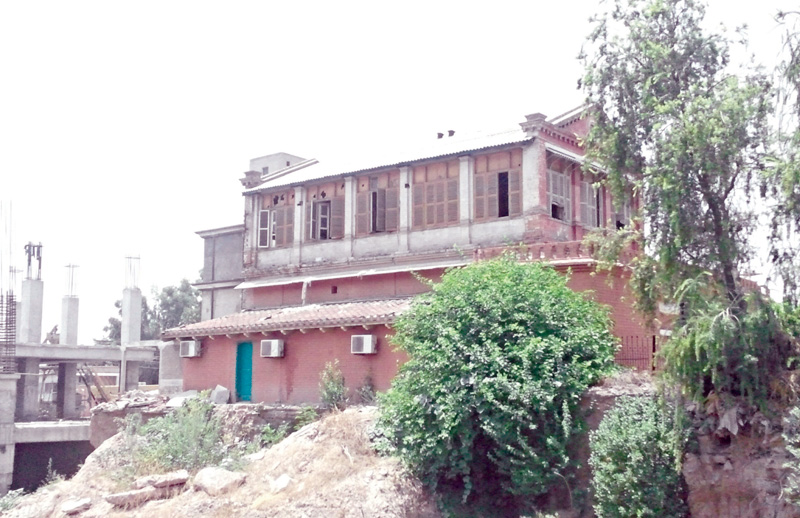
Out with the old and in with the new seems to be the motto of the administration of the Lady Reading Hospital as it has decided to demolish the upper storey of its PGMI Auditorium Hall constructed during the British era.
Last year’s monsoon rains severely damaged the hall’s first floor which once served as a ward for women afflicted by tuberculosis. The administration that initially remained unconcerned with preserving the structure built in 1936, ultimately decided that since the damage was irreparable the entire upper storey should be demolished and rebuilt.

Last year’s monsoon rains severely damaged the hall’s first floor which once served as a ward for women afflicted by tuberculosis. It was built in 1936. PHOTOS: HIDAYAT KHAN/EXPRESS
The rear end of the damaged floor has already been bulldozed to make way for new construction. However, the demolition only made matters worse for the ground floor. The entire structure has now become unstable and a historical remnant of the British era is very likely to fall to the ground and be lost forever.
LRH spokesperson Syed Jameel Shah told The Express Tribune that the administration had no intentions of removing old sections of the establishment. “These historical buildings add to the charm of the hospital, but unfortunately the condition of the upper portion of the PGMI Hall had been deteriorating and the administration was not able to maintain it,” said Shah.
He added that as the administration feared the entire structure would collapse, it decided it would be best to bring down the upper storey and rebuild it. “The most damaged sides were torn down and since construction of new wards and the OPDs is going on, the hall’s upper storey will also be rebuilt,” said Shah.
Historic architecture
Monuments and sites which are over 70 years old are protected under the Antiquities Act 1975, according to Khyber-Pakhtunkhwa Archaeology and Museums Director Dr Abdul Samad.
A programme has been chalked out to preserve historical monuments and buildings across the province and LRH is among them, Samad told The Express Tribune.

Last year’s monsoon rains severely damaged the hall’s first floor which once served as a ward for women afflicted by tuberculosis. It was built in 1936. PHOTOS: HIDAYAT KHAN/EXPRESS
The director said the hospital’s administration should hand the building over to the archaeology department so that it can be restored and repaired technically. “We have restoration experts who can help maintain the classic colonial structure of the building,” he added.
The PGMI Auditorium Hall was previously a 20-bed TB ward named after Sir Charles Brierley, former inspector general of LRH. The ward was inaugurated on May 11, 1936 by Sir Ralph Griffith, the governor of the erstwhile North-West Frontier Province. Later, the ward was converted into an auditorium and renamed PGMI Hall.
City’s largest hospital
Located right in the backyard of the historic Balahisar Fort, the LRH, named after Lady Reading, the wife of Lord Reading who served as viceroy of India from 1921 to 1926, is one of the largest tertiary care hospitals in the country.
The 30-acre hospital is never empty as hundreds of people, some patients, some relatives, some staff and others just passing through, stream through its many gates. Right across the compound are the bustling Qissa Khwani, Khyber and Ander Sheher bazaars with their narrow lanes and countless shops.

As Khyber-Pakhtunkhwa has borne the brunt of militancy which has crept into the country, the LRH by default is the first medical facility to which casualties are taken. Over the past decade, the 1,700-bed hospital has seen all kinds of patients from victims of hundreds of suicide blasts to target killings and natural disasters.
A revelatory fall
For a hospital that has treated unimaginable injuries, it is ironic that it owes its existence to an accident as small as a fall from a horse.
During his time as the viceroy, Lord Reading and his wife visited Peshawar. Lady Reading was fascinated by the view of the city of flowers from Balahisar Fort, the quarters the couple was lodged in. Wishing to sightsee, Lady Reading requested a trip and was provided a horse but on the way back she fell from it.
She was rushed unconscious to Agerton Hospital, however, the facility could not cope with her injuries and she was then shifted to the Royal Artillery Hospital now known as Combined Military Hospital, Peshawar.
The incident left a lasting impact on Lady Reading and upon her husband’s retirement she arrived from Delhi to the city and campaigned for the construction of a well-equipped hospital in place of Agerton.
Sir Charles Brierley played a key role in the completion of the project and was also assigned the task of serving as the administrator. Sir Brierley was later elevated to the post of Inspector General and the TB ward was named after him.
The new hospital ultimately took Lady Reading’s name and has been serving the people of the city ever since.
Published in The Express Tribune, August 6th,2014.



1730959638-0/trump-(19)1730959638-0-165x106.webp)







COMMENTS
Comments are moderated and generally will be posted if they are on-topic and not abusive.
For more information, please see our Comments FAQ